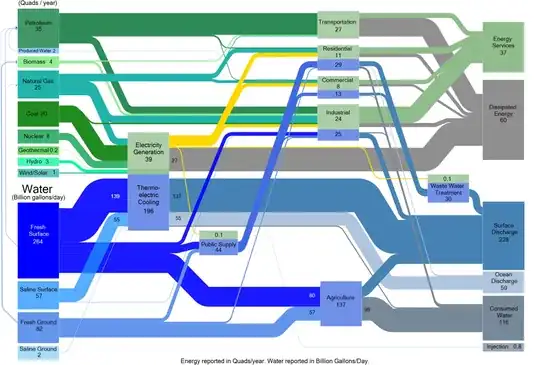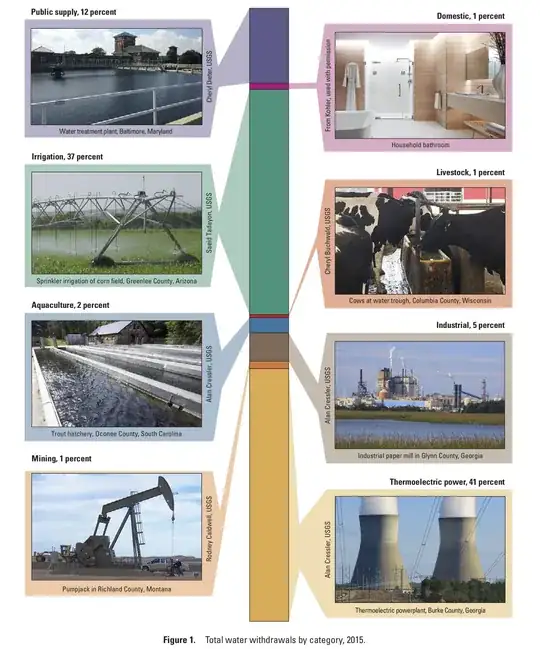No, the claim is faulty on both parts
Using the US Geological Survey report on Estimated use of water in the United States in 2015, we quickly see that the original claim that thermoelectrical power-plants consume the most water is not correct.
Table 2A shows that thermoelectrical power plants do withdraw 133,000 Mgal per day, and that is on par with irrigation, and those two together are the top withdrawers. But 96-97 percent of the water that power plants withdraw is discharged back into the environment and is available for use downstream without further treatment. The consumptive use is only 4,310 Mgal per day (Table 12).
With a consumptive use of only 4,310 Mgal/day, power plants consume much less than Irrigation (Table 7), at 73,200 Mgal/day, which is 17 times as much.
So when the original claim says that:
Nationally, the largest category for water consumption is electric power generation.
...that claim is false.
As for usage of electricity, the claim that making water available is the largest consumer of electricity: no, that is not true either.
As explained by United States Energy Information Agency, the Commercial, Industrial and Residential(**) sectors share about equal parts of electricity use.
Water supply sorts under the "Commercial" sector:
The commercial sector includes retail, office, education, institutional, public, and government facilities, and public services such as water supply, sewage treatment, telecommunications equipment, and outdoor and public street lighting.
...and the commercial sector is listed as using electricity for the following:
- Refrigeration—14.0%
- Ventilation—11.2%
- Lighting—10.6%
- Space cooling—10.6%
- Office equipment —7.8%
- Computers and related equipment—7.5%
- Space heating—2.6%
- Cooking—1.8%
- Water heating—0.6%
- Other miscellaneous uses combined—33.3%
So water treatment and water transportation do not even have their separate posts, but instead get sorted in under misc. uses, presumably using less electricity than the 0.6% listed — in the commercial sector only, not 0.6% of all use — for water heating.
Hence that part of the claim is wrong too.
Edit: "Use" vs "Consume"
The original claim is the following...
Energy Water Nexus Technical Conference: Driving Savings in Manufacturing
Nationally, the largest category for water consumption is electric power
generation. Similarly, the largest demand for electricity is water extraction and distribution. This strong interdependence drives great opportunity in the Energy-Water Nexus (EWN) to impact both energy and water consumption.
So what is an Energy Water Nexus? Turns out Wikipedia has a page on that...
There is no formal definition for the water-energy nexus - the concept refers to the relationship between the water used for energy production, including both electricity and sources of fuel such as oil and natural gas, and the energy consumed to extract, purify, deliver, heat/cool, treat and dispose of water (and wastewater) sometimes referred to as the energy intensity (EI).
Further down the page, we find the following. Emphasis is original, bold is my addition.
Water can either be used or consumed, and can be categorised as fresh, ground, surface, blue, grey or green among others. Water is considered used if it does not reduce the supply of water to downstream users, i.e. water that is taken and returned to the same source (instream use), such as in thermoelectric plants that use water for cooling and are by far the largest users of water. While used water is returned to the system for downstream uses, it has usually been degraded in some way, mainly due to thermal or chemical pollution, and the natural flow has been altered which does not factor into an assessment if only the quantity of water is considered. Water is consumed when it is removed completely from the system, such as by evaporation or consumption by crops or humans. When assessing water use all these factors must be considered as well as spatiotemporal considerations making precise determination of water use very difficult.
So, in the context of talking about Energy Water Nexus / water-energy nexus, there is indeed a vital difference between claiming water has been "used" or if it has been "consumed".
The only way the claim about thermoelectric plants and water can be true is if whoever wrote that flyer made a mistake, and erroneously wrote "consumption" when they actually meant "usage". I personally find that to be either unlikely, or really embarrassing on part of someone that supposedly calls to a conference on the subject and thus should know the difference.
And no matter that, it still does not make the second part of the claim — about electricity being used the most for producing and moving water — true.
The following graphic, from the same Wikipedia page...

Water / Energy usage and respective dependencies. Image Source: US Department of Energy - Bauer, D., Philbrick, M., and Vallario, B. (2014). "The Water-Energy Nexus: Challenges and Opportunities." U.S. Department of Energy. Public Domain
...shows that electricity usage to produce water and waste waster treatment is 0.1 and 0.1 Quads per year (0.1 Quad = 29 TWh) respectively, while other usage of electricity is substantially more.
The same graphic also shows a very tiny portion of water leaving the "Thermoelectric Cooling" box and going into the "Consumed Water" box. The sums of other connectors means that — according to that graphic — water is consumed at a rate of 2,000 Mgal per day out of 196,000 Mgal/day used for thermoelectric cooling.
(**) Anyone else get SimCity vibes from that? :D

